The following description of the Fitzgerald House was compiled in 1998, three years after the house and its kitchen were moved from their original site on Tara Road to Betty Talmadge’s Lovejoy Plantation. Prepared for Mary Rose Taylor, then-director of the Margaret Mitchell House, Inc., it was intended as a preliminary investigation to assess architectural integrity, and only one day was spent on site with the buildings. Unfortunately. circumstances did not permit any subsequent followup work. Thus, the dreadful and thoroughly inadequate photography, which was, unless otherwise noted, done by the author in 1998.
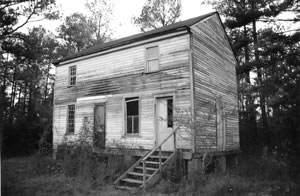
Figure 1. The Fitzgerald House at Lovejoy Plantation. |
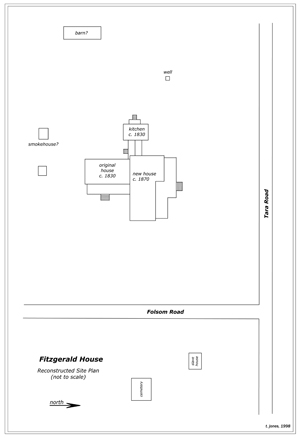
Figure 2. Reconstructed site plan of the Fitzgerald House and outbuildings on their original site. (Drawing by author)
|
Site
The original site of the Fitzgerald House at the southwest corner of Tara Road and Folsom road in southwestern Clayton County remained undeveloped fifteen years after the house was moved off the property. Locations and possible ruins of buildings and other landscape features may have survived on the overgrown site, including a slave cemetery according to the State Historic Preservation Office’s survey of the site in 1977. Because of the relatively undisturbed nature of the site, which encompasses several acres, the potential for archaeological resources was high. A full investigation of the site could provide significant information about details of the house’s construction and evolution and of the Fitzgerald’s antebellum plantation and post-bellum farm. In particular, site investigation could confirm the precise original location of the original house and kitchen, one or the other of which may have been moved when the 1873 addition was made. It could also shed light on when and how the original breezeway connection between the kitchen and house was constructed.
The number and location of slave houses and other outbuildings on the historic plantation has not been identified but they may be the “guest houses” that Stephens Mitchell and others remembered surrounding the main house. At least one slave or tenant house was identified in the SHPO survey of Clayton County in 1977 as being located across Folsom Road from the main house, and there may have been others as well.
Structure
The building is currently set on dry-laid concrete block piers. The original piers of the house were likely to have been stacked stone but they may have been replaced by brick in the 1870s. Although the original end chimneys could have been entirely of stone, the newer center fireplaces had a stone foundation and a brick chimney shaft.

Figure 3. Typical first-floor joists and front sill. |

Figure 4. Chimney shaft framing. |

Figure 5. Attic and roof framing. |
Sills are hewn, 11” to 12” square, and are continuous and not spliced on the front and rear of the house. The original hewn sill at the north end of the house has been lost, probably during the 1873 construction. The hewn sills at the south end of the house mark the location of original chimney and fireplaces. The hewn corner posts run continuous from sill to top plate.
First floor joists are pine logs, hewn flat on one side, and running east to west (front to back). The five log joists under each of the first floor rooms are 9” to 10” in diameter, placed on 28” to 30” centers. At the center of the house are three additional joists placed about 24” on center. The center joist here is over 13” diameter and marks the line of the original partition wall between Room 101 and Room 102. The second floor ceiling joists are also hand-hewn, 4” by 6” and placed 28” to 30” on centers.
All other framing material in the house appears to be sawn, with the earliest lumber being sawn with reciprocating saws while later additions bear the mark of circular saws. Second floor joists (first floor ceiling joists) are probably 3” by 7”, which is the dimension of the single joist that is visible along the west (rear) side of the chimney shaft. Original wall studs are generally 3” by 4” with later alterations marked by material 2” by 4” or less.
Rafters are also generally 3” by 4,” mortised and pegged without a ridge board and without wind braces.
Empty mortises spaced about 28” on center can be seen across the length of the rear sill. These almost certainly indicate the presence of one or more rooms across the rear of the original building. That this was a closed interior space and not an open porch is indicated by the fact that the mortises are for joists, which would have typically been installed parallel to this sill had the space been originally framed as a porch.
In addition, interior changes on the north side of the west (rear) window in 201 indicate the possibility that the rear windows on the second floor may have originally been much shorter in order to accommodate a one story roof above these rooms. As repairs are made to the rear siding, additional evidence for these rooms may come to light. However, the apparent age of the siding and nails used on the rear of the existing house, indicate that these rooms were probably removed (or perhaps destroyed) well before 1873.
Exterior
The exterior of the house was originally sided with sawn boards, ⅝” to ¾” by 6”, laid with a lap of about 5”. All of the existing siding may not be original, particularly on each end where chimneys were removed. When the existing door and window were installed in the east (front) wall of 102 in 1873, the siding was relaid at the north end of the first floor with a 4½” lap and using cut nails with a smaller head than was used on the earlier siding on the east, south, and west sides of the house.

Figure 6. Front (originally east-facing) of Fitzgerald House |
.jpg)
Figure 7. Rear of Fitzgerald House. |

Figure 8. Typical second-floor window and boxed eaves. |
Original second-floor windows were single hung, 6/6 sash; first-floor windows were also single hung, but 9/9 sash. Windows added in the 1870s had 2/2 sash with vertical lights typical of the period.
The existing six-panel door at the original front door opening is not historic. The other front door has four raised panels, typical of the late nineteenth century and is thought to have been added in 1873.
Historically, the roof was covered with wood shingles. Earlier wood shingles and decking are now covered with several layers of asphalt shingles.
The ghost of an early porch roof approximately 8’ wide can be discerned on the siding above the front door. There are no mortises or other evidence in the front sill to indicate the presence of a porch floor to go with this roof, although there is evidence of a pair of stringers for stairs at the original front door into Room 101. The porch posts were likely set on flat stones placed on the ground for that purposes.
The front porch that was dismanteld in 1982 appears to have been constructed prior to 1873. Its style as seen in an early photograph and the character of the existing porch columns indicate that it may have been constructed in the 1850s or 1860s. Columns are paired posts, 3½” square with ½” chamfered corners, and decorative brackets; only two full columns and part of a third have been located. As the stored material is sorted and separated, additional material from this porch may come to light.
Interior
The interior of the house was remodeled in 1873, when the center chimney and flanking closets were constructed. Molded casing and bulls-eye corner blocks were added to the window and door openings in Room 102 at that time and all of the openings in that room were altered. The interior was remodeled again about 1930, when the existing V-joint paneling was installed on the walls and ceilings in Rooms 101 and 102. There were almost certainly a number of changes before 1873, including perhaps addition of the second front door from Room 102 but these cannot be identified without removal of twentieth century paneling and other materials.
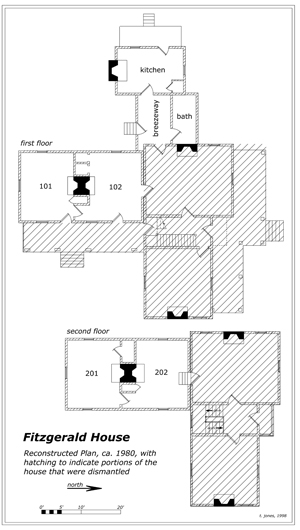
Figure 9. Floor plan of Fitzgerald House at the time it was dismantled. (Drawing by author) |

Figure 10. The original flooring on the first floor, seen from below, covered with new flooring in 1873. |
The interior of the original house had walls, floors and ceilings that were boarded in a manner typical of the second quarter of the nineteenth century. Most of these remain in place, although sometimes removed and re-used from other locations. The floor and ceiling in Room 102 was replaced, either in 1873 or earlier when the room began to be used as a dining room. All of the original (ca. 1835) doors appear to have been replaced in the late nineteenth century.
A significant amount of wallpaper, some of it dating to the mid-nineteenth century, is visible on the second floor and survives under the ca. 1930 paneling on the first floor. Much of the interior wood trim was grained, probably in the 1870s, and has not been overpainted. A comprehensive study of the painted and wallpapered finishes would be a necessary part of a restoration process and could provide significant information about the building’s evolution.
Most if not all of the doors are in storage, although most of these appear to date to the 1873s remodeling. All of the original mantels (probably dating to the 1830s) are in storage.
The original staircase was removed when the center chimney was constructed, but evidence for its placement exists in the infilled flooring in the southwest corner of Room 202. In addition, the reverse side of one of the boards that was used for construction of the east wall of the closets off Room 102 is visible in the vacant chimney shaft and shows the painted outline of two treads and a rise from this original staircase.
Room 101
Located at the south end of the first floor with entrance through the original front door, this room measures approximately 15’-8’ north and south and 17’-4” east to west (or front to rear). It was probably used as the “hall” in the original “hall-and-parlor” plan of the house. As such, both Chambers and Fitzgerald would have used this room as their primary living room, with the north room (Room 102) being the “parlor” or more private sleeping area. The original fireplace in the south wall was replaced by the existing window when the house’s end chimneys were removed in 1873 if not before. Because the main entrance to the house was into this room, the stairway to the second floor probably rose from the northwest corner of this room, but it was removed when the center chimney and flanking closets were constructed. The outline of two treads and a riser, almost certainly from this staircase, can be identified on the reverse side of one of the re-used wall boards in the 1873 pantry off 102. If there were in fact an additional room or rooms at the rear of the house, a doorway would have connected the existing room to those rear rooms.
|
Figure 11. Room 101. |

Figure 12. Room 101. |
Floor: Original flooring is heart pine, approximately 1¼” thick and ranging from 4½” to 7½” in width, no rabbetted edges or tongue-and-groove, laid running north and south; mostly intact. Later flooring overlays original and is 2½” wide, tongue-and-groove oak; this last flooring may obscure evidence of original hearth opening at south end of room.
Ceiling: Original floor-to-ceiling height was 8’-9”; original ceiling was put up with pine boards, 6” to 7” wide, laid running north and south. V-jointed, tongue-and-groove oak boards, installed over original board ceiling (ca. 1930); boards are 3¼”, 5¼”, and 7¼” widths are regularly repeated and are laid running east and west.
Walls: Original wall covering was horizontal boards, probably 10” to 12” wide; now covered with vertically-installed, V-joint oak boards like those used on the ceiling. Corners are finished with lattice strips, grained to resemble oak.
Doors: The small portico “ghost” on the front of the house suggests that the door in the east wall of this room was the original front entrance to the house. The height of the original opening has probably been enlarged and the existing door probably dates to the 1873 remodeling. The front door is four-panel, 3’-0” by 7’-5”, pine with oak graining. The original door casing has been replaced (c. 1873) by molded casing, 5” wide, with bulls-eye corner blocks but no plinths. The door between this room and 102 marks the original dividing wall between 101 and 102 but has probably been enlarged to its present dimensions of 3’-0” by 7’-0”. The door itself is missing but the 1873 molded casing and corner blocks remain intact. The door to the small closet on the east side of the fireplace is also missing. It measured about 2’-0” by 7’-0”.
Windows: Two windows are in this room, on east and west walls, both 2’-11” by 5’-11”, 2/2. West (rear) window is set about 20” above the floor while east window is set about 24” from floor, perhaps indicating that rear window was originally a door opening. Windows are trimmed with molded casing typical of the 1873 renovation.
Trim: Simple 1” by 10” baseboard with no base cap or shoe molding, probably installed ca. 1930. 3” crown molding installed upside down, added with V-joint paneling of walls (ca. 1930).
Lighting: A single overhead electric light fixture, globe missing, probably added in the 1930s.
Finishes: Door and door and window casing are all grained to resemble oak, probably in the 1870s.
Fireplace: Original fireplace in south wall was replaced by new fireplace on north wall in 1873. This second fireplace was dismanteld in 1982 when the house was moved and the original mantel to this room is now installed in the Crawford-Talmadge House.
Room 102
Located at the north end of the first floor, this room measures approximately 15’-8’ north and south and 17’-4” east to west (or front to rear). It was probably used as the “parlor”or more private sleeping area in the original “hall-and-parlor” plan of the house. The placement of the existing window in the west wall suggests that it infills an earlier door opening. The east wall was rebuilt when the existing window and door were installed, perhaps prior to 1873. The original fireplace in the north wall was replaced by the existing door when the house’s end chimneys were removed c. 1873 or before.
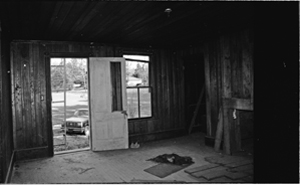
Figure 13. Room 102.
|

Figure 14. Room 102. |
Floor: Earliest flooring in this room, now overlaid with a later floor, differs from that in 101. This flooring is about ⅞ by 3¼” tongue-and-groove, circular sawn, laid running north and south. It has been overlaid with oak flooring, 2½” wide, laid running east and west.
Ceiling:Original floor-to-ceiling height was 8’-9”; earliest ceiling was put up with pine boards, 3” wide, tongue-and-groove with a beaded edge. Now overlaid with V-jointed, tongue-and-groove boards, installed ca. 1930; boards are 3¼”, 5¼”, and 7¼” widths are regularly repeated and are laid running east and west.
Walls: Original wall covering was horizontal boards, probably 10” to 12” wide; now covered with vertically-installed, V-joint boards like those used on the ceiling.
Trim: Simple 1” x 10” baseboard with 3/4” quarter-round base cap and shoe molding, probably installed in 1930. Earlier shoe molding remains in place on part of north wall. 3” crown molding installed upside down, added with V-joint paneling of walls (c. 1930).
Doors: The door and window in the east wall of this room replaced the original window in that wall. The door resembles the other front door in 101, is four-panel, 3’-0” by 7’-5”, pine with oak graining. The doors to the closets on the west side of the fireplace are missing. Openings measure about 1’ -8” by 7’-0”.
Windows: Three windows are in this room. All had sash approximately 2-’4” by 5’-8”, 9/9 divided lights. The window opening in the south (or end) wall was created when the original fireplace was removed, although the sash itself may have been re-used from elsewhere in the house. All elements of the front (or east) window remain intact and probably date to the original construction of the house in the 1830s. Casing is made with ¾” by 2¼” plain sawn boards; window stop features a wide, half-round bead on the inside face; original window stool measures 2” by ⅝”; no apron present. On the south window, casing is intact but both sash are missing all muntins and glass. On the west window, only the window stool remains in place.
Lighting: A single overhead electric light fixture, globe missing, probably added in the 1930s.
Finishes: Significant amounts of historic wallpaper probably remain on the walls beneath the 1930s paneling. Door and door and window casing are all grained to resemble oak, probably in the 1870s.
Fireplace: Original fireplace in north wall was replaced by new fireplace on south wall in 1873. This second fireplace was dismantled in 1982 when the house was moved. The mantle is in storage.
Room 201
Located at the south end of the second floor, this room has been little altered since 1873 and some of its original (c. 1835) materials remain in place.
Floor: Original flooring remains in place; 1¼” by 5½” to 7½” wide; laid running north and south.
Ceiling: Floor-to-ceiling height is 6’-6”; original ceiling intact; ⅞” by 10” to 12” boards.
Walls: Original wall covering is horizontal boards, probably 10” to 12” wide; mostly covered with wallpaper.
Trim: No baseboard; lowest wall board was painted while wall above that was wallpapered; corners finished with grained lattice strips applied over wallpaper.
Doors: The door between this room and room 202 is missing; opening is 3’-1” by 6’-5”; note lock plate on jamb and broken hinges, both probably original. The door to the closet on the west side of the fireplace is missing; opening is 33” by 75”; casing is plain, 1” by 5¼”.
Windows: Three windows are in this room. All had sash approximately 2’-4” by 3’-10”, 6/6 divided lights. The window opening in the south (or end) wall was created when the original fireplace was removed, although the sash itself may have been re-used from elsewhere in the house. East window sash and casing is intact, stool missing; south window, all elements missing except for exterior sill and top interior casing; west window all elements missing except for frame and top interior casing.
Lighting: Single overhead light fixture, c. 1930.
Finishes: Several layers of wallpaper survive on the walls; ceilings painted; woodwork grained to resemble oak.
Fireplace: Original fireplace in south wall was replaced by new fireplace on north wall in 1873. This second fireplace was dismantled in 1982 when the house was moved. The mantle is in storage.
Room 202
Located at the north end of the second floor, this room contains the steps and door that this floor to the 1873 addition. The original (c. 1835) staircase to the first floor was probably located in the southwest corner of this room.
Floor: Original flooring remains in place; 1¼” by 5½” to 7½” wide; laid running north and south.
Ceiling: Floor-to-ceiling height is 6’-6”; original ceiling intact; ⅞ by 10” to 12” boards.
Walls: Original wall covering is horizontal boards, probably 10” to 12” wide; mostly covered with wallpaper.
Trim: No baseboard; lowest wall board was painted while wall above that was wallpapered.
Doors: The door between this room and room 202 is missing; opening is 3’-1” by 6’-5”. The door to the small closet on the east side of the fireplace is missing; opening is 22” by 76”. Door opening on north wall was created in 1873 and provided access from the second floor of the 1873 addition; rough opening only remains, no door, frame, or trim. Three wooden steps, 43” wide, 9” rise and 8” run; no railing.
Windows: Two windows are in this room; east window remains intact; west window sash missing, casing intact; original sash approximately 2’-4” by 3’-10”, 6/6 divided lights.
Lighting: Single overhead electric light fixture, c. 1930.
Finishes: Several layers of wallpaper survive on the walls; ceilings painted; woodwork grained to resemble oak. Note wallpapers on boards on south wall, which were probably re-used from one of the first-floor rooms.
Fireplace: Original fireplace in south wall was replaced by new fireplace on north wall in 1873. This second fireplace was dismantled in 1982 when the house was moved. The mantle is in storage.
Kitchen House
The Ktchen House, but not the screened porch or breezeway, appears to have been built about the same time as the original house. It has hewn sills, log joists, and boarded ceiling, walls and floor that are similar to those found in the main house. At some point, it was connected to the original house by the existing breezeway, which seems to have been constructed prior to the 1873 expansion of the house. However, no evidence has been located as to how or where that connection might have been made. When the house was expanded, the kitchen may have been moved, which would have necessitated demolition and reconstruction of the chimney. The existing porch may have been added in the twentieth century, perhaps at the same time that the bathroom was added to the breezeway.
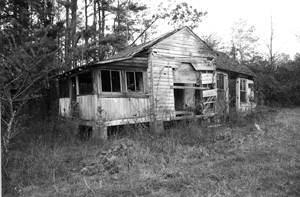
Figure 17. View of kitchen and its back porch, left, and breezeway, right.
|
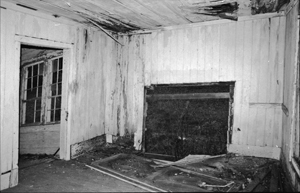
Figure 18. View of kitchen and door to breezeway.
|
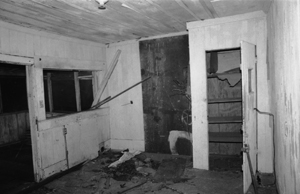
Figure 18. View of kitchen and added pantry.
|
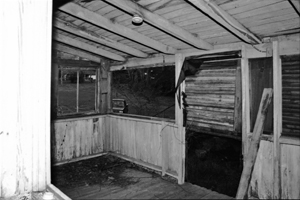
Figure 19. View of back porch to kitchen.
|
Floor: Original flooring is pine, 6” to 7” wide, laid running east to west; now covered by pine flooring, 3½” wide, running north and south, installed ca. 1930.
Ceiling: Ceiling set at about 8’-1”, finished with 1” by 10” boards running east and west, joints covered by wood strips,¼” by 1½”, probably modern.
Walls: Walls were originally boarded, random widths, horizontally laid; these remain but are now covered with V-joint boards, vertically installed, similar to that in Rooms 101 and 102, installed ca. 1930.
Trim: Original baseboard is 1” by 10”, with no cap or shoe. 3½” crown molding installed along with V-joint paneling, ca. 1930.
Doors: Two doors; opening from back porch is 3’-0” by 6’-5” and may be original; opening from breezeway is 3’-2” by 6’-7” and may be original but relocated from center of that wall.
Windows: Two original window openings, one on west wall and one on south wall; both with original frame, 2’-4” by 5’-6”, fixed top sash, all sash missing. A large window opening, 5’-6” by 2’-10”, added c. 1940 (?) on south wall, probably with sliding sash which are now missing.
Lighting: A single ceiling-mounted electric light fixture, ca. 1930, no globe.
Finishes: .Walls, ceilings, and trim have been painted.
Fireplace: The fireplace and chimney are reported to have been stone; both are now missing as is the mantle piece; original fireplace opening in east wall measures 5’-6” wide by 4’-4” high with a hearth about 24” deep. A hole for a stove pipe is now visible in the southeast quadrant of the ceiling.
Other: In the northwest corner of the room, a small pantry was constructed out of vertical, beaded, tongue-and-groove boards that are similar to those used on the interior of the breezeway and on the ceiling of Room 101. Door is constructed of the same material and has a small screened opening in the upper part of the door. Original kitchen wall boards are visible in this closet.
Breezeway
Because the end of the breezeway that originally connected to the house is now collapsed, a complete investigation of this structure was not possible. Conclusions about its construction and evolution must remain tentative until further investigation is possible as the structure is repaired and stabilized.
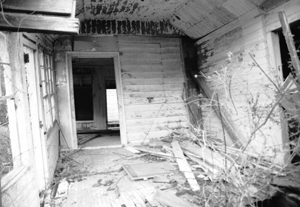
Figure 20. Interior of breezeway, looking toward the kitchen. Door opening partially visible at right is to the bathrooom. |
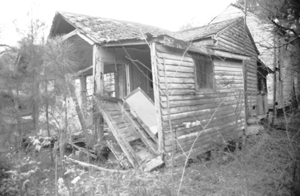
Figure 16. View of post-WWII bathroom attached to breezeway. |
The breezeway was connected to the rear end of the west side of the 1873 addition but with its south wall located some two feet beyond the south wall of the main house. (Evidence for the intersection of the breezeway roof and the northwest corner of the original house can be noted in remnants of tar and flashing on the north end of the west (rear) side of the house.) Since it is unlikely that the breezeway would have been built in 1873 out of alignment with the addition, it is assumed that the breezeway was built prior to that time.
The existing breezeway is not as old as the kitchen and original house, however, being put up with circular sawn framing and finished with 4½”, beaded, tongue-and-groove boards similar to that used for the kitchen pantry and on the ceiling in Room 101. The breezeway may date to the late 1850s or 1860s. The width of the structure may have been increased to its present dimension in the 1870s. The breezeway was remodeled with the addition of windows on the south wall in 1929 at the same time that a bathroom was constructed on the north side of the breezeway. The bathroom, which was wood-framed and included an enameled steel bathtub at its east end, is now in thoroughly ruinous condition.
Floor: Original flooring is not fully visible but appears to have been 4½” wide, tongue-and-groove pine, running east and west; overlaid ca. 1930 with existing oak strip flooring, 1¾” by ¼”, running north and south.
Ceiling: The ceiling, which is set at about 9’-4”, is finished with 4½” beaded tongue-and-groove boards.
Walls: Walls are also finished with beaded, tongue-and-groove boards, but only 3¼” wide where they follow the slope of the rafters from the top of the windows to the ceiling.
Doors: Originally three doors in addition to door into kitchen; door on south wall, 2’-9” by 7’-6”, reduced to 6’-8” ca. 1930; door to bathroom on north wall, 2’-6” by 6’-8”, installed ca. 1930, reusing earlier door of which stiles and rails only remain; placement or dimension of door to 1873 addition at east end has not been determined.
Windows: The breezeway appears to have been enclosed without window openings prior to 1929, although the earliest configuration of the structure may have included no walls at all. The two windows at the east end of the south wall measure 2’-4” by 4’-6”, 6/6, and were installed ca. 1930. The single window at the west end of that wall is 2’-0” by 4’-6”, 4/4, and was probably installed at the same time; sash may have been re-used from elsewhere.
Lighting: A single ceiling-mounted electric light fixture, ca. 1930, no globe.
Finishes: All woodwork, except flooring is painted.
1873 Addition
The 1873 addition was a wood-framed structure, two stories high, set on brick piers. It had a full length porch on the front (north) side and a smaller porch off the second floor stair hall above the front entrance. The house was sided with 6” siding with 4½” lap and featured sawn barge boards and porch trim in Italianate design. The plan included a central stair hall, bedroom, and parlor on the first floor and a stair hall and two bedrooms on the second floor, with connections on each floor to the original house at the rear (south) side of the 1873 addition. Interior walls and ceilings were plastered and floors were tongue-and-groove pine boards, 3½” by ⅞. Doors were four-paneled, mostly 7’6-” tall, and windows were generally double-hung, 2/2, mostly 2’-11” by 6’-8”.
In 1982, the 1873 addition was dismanteld. Contemporary photographs and inventory of the dismanteld materials has not been located and the current condition of the material makes a precise inventory impossible at this time. However, the following items were salvaged and are in storage:
- most (90%?) of the framing material, including corner posts and sills that document the exact
dimensions of the structure;
- some (1/3?) of the original siding, including that which was temporarily installed to cover the north end of the house;
- some (50%?) of the decorative exterior woodwork;
- most (90%?) of the windows and all of the doors, including some screen doors; distinctive Victorian entry with splayed jambs and elaborately detailed door is intact;
- two mantelpieces; one Victorian, 51” high and 55”, wide with reeded brackets, reeded mantel shelf and molded pilasters, painted, probably located in east room on first floor; one painted white, 63” high and 60” wide, with boxed mantel shelf, 7” by 11-¼” and boxed columns and pilasters, probably located in west room on first floor; upstairs rooms may not have been heated.
- most (90%?) of the interior woodwork, which include bulls-eye corner blocks and molded 5” door and window casing;
- most (95%) of the main staircase, including stringers, treads, risers, nosing, balusters, banisters and three newel posts;
- an undetermined number of stones and brick, probably 50% of the original material.
In addition to loss of some of the above materials, other parts of the 1873 addition that have been lost include:
- all of the interior plaster and all but a few feet of the plaster lath;
- all of the original roof shingles and decking;
- most of the front porch, which had collapsed prior to the move.

|